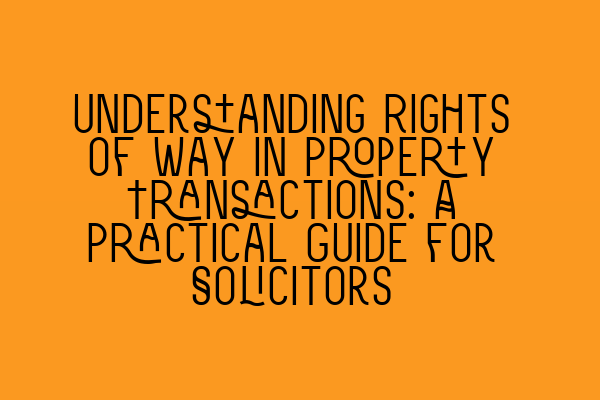Understanding Rights of Way in Property Transactions: A Practical Guide for Solicitors
As solicitors practicing property law, it is crucial to have a comprehensive understanding of rights of way in property transactions. Rights of way can significantly impact the use and value of a property, and navigating through the legal complexities surrounding them is essential for providing reliable advice to clients.
What are Rights of Way?
A right of way is a legal easement that allows an individual to pass through or use a specific portion of another person’s land. This right is granted to provide access to a property or to benefit neighboring properties that may not have direct access to a public road.
There are two main types of rights of way: express and implied. Express rights of way are explicitly granted through a legal document, such as a deed or agreement. Implied rights of way, on the other hand, are not specifically mentioned in a written document but are implied by the circumstances surrounding the property.
Identifying Rights of Way
When undertaking property transactions, it is crucial to identify any existing rights of way to avoid future disputes. This can be done by thoroughly examining the property’s title deeds, conducting searches with the Land Registry, and reviewing any past agreements or documentation.
During the due diligence process, solicitors must pay close attention to any references to rights of way and carefully review the extent and limitations of these rights. It’s also important to inspect the physical boundaries of the property and identify any visible signs of rights of way, such as pathways or gates.
Interpreting Rights of Way
Interpreting rights of way can often be complex, requiring a deep understanding of property law principles. This involves examining the language used in the relevant documents, considering any surrounding circumstances, and assessing case law precedents.
When interpreting rights of way, solicitors must pay attention to key details such as the width of the right of way, the specific purposes for which it can be used, and any restrictions or limitations imposed on its usage. This information is crucial for advising clients on their rights and obligations.
Rights of Way in Property Transactions
When dealing with rights of way in property transactions, it is essential to ensure that all necessary rights are properly transferred or granted to avoid any future disputes or complications. This requires careful drafting of legal documents, such as transfer deeds or leases.
For properties benefitting from existing rights of way, solicitors must ensure that these rights are properly documented and included in the new property’s title. Failing to do so may result in the loss of these rights, negatively impacting the property’s value and usability.
Similarly, when a property grants a right of way to another party, solicitors must clearly define the scope and limitations of this right to protect the property owner’s interests. This includes establishing any maintenance responsibilities, setting out permissible usage, and addressing any potential disputes.
Avoiding Common Pitfalls
Understanding some of the common pitfalls associated with rights of way is crucial for solicitors practicing property law. Here are a few key points to consider:
- Ensure all rights of way are documented and properly registered.
- Pay attention to any potential rights of way disputes or conflicts.
- Consider the impact of rights of way on property value and marketability.
- Advise clients on any additional obligations or responsibilities associated with rights of way.
Conclusion
Rights of way can significantly impact property transactions, and solicitors must have a deep understanding of their nuances to provide effective advice to clients. By identifying, interpreting, and properly documenting rights of way, solicitors can help their clients navigate through property transactions and avoid potential disputes.
For further resources and training to enhance your knowledge and skills in property law, consider exploring our SQE 1 Practice Exam Questions and SQE 1 Practice Mocks FLK1 FLK2. Additionally, you may find our SQE 2 Preparation Courses and SQE 1 Preparation Courses valuable for further training and development. Stay updated with the latest SRA SQE Exam Dates to ensure you are well-prepared for the qualification process.
